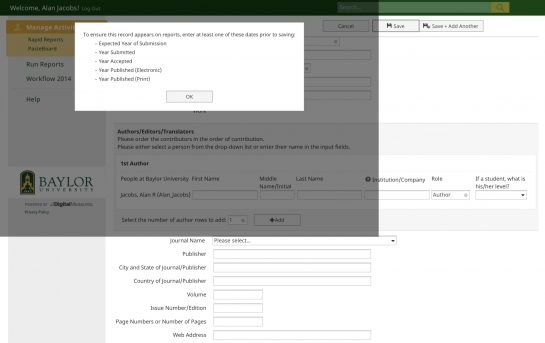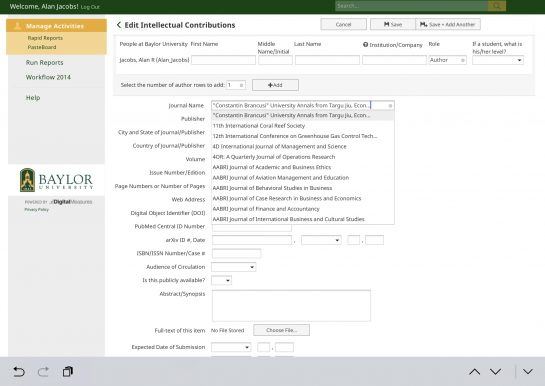This year we in the Honors Program at Baylor were told that we could no longer submit our annual activity reports as MS Word files. Instead, we must use an “instrument” called Digital Measures. Just take a look at that website and you’ll see what Digital Measures is all about: things like “THE WORKFLOW MODULE for ACTIVITY INSIGHT.”
What’s it like to use Digital Measures? Let’s suppose that you want to enter the data for a journal article that you’ve recently published. Digital Measures cheerfully tells you that you can just import a BibTex file, which is helpful if the journal in which you have published the article, or a database in which that journal is available, happens to make a BibTex record available. But of course you’re not likely to know that without some searching. That can be time-consuming, though not nearly as time-consuming as entering the information manually — so maybe it’s worth the trouble.
Because if you have no luck finding a BibTex file for your article, then the fun starts in earnest. How to record a journal article? You go to the landing page and discover that there are thirty-five categories in which you can enter data. Let me spare you some time and tell you that the one you’re looking for is called “Intellectual Contributions” (which suggests, by the way, that much of the rest of what you do as a faculty member does not involve “intellectual contributions”). So you click on that.
Congratulations! You are now faced with a page containing no fewer than forty-six form fields. Surely DM does not expect you to fill out all forty-six? Indeed Digital Measures does not have this expectation. However, the UI experts who designed this page did not see fit to let you know which of the forty-six fields are required and which optional — even though few practices are more standard in database UI design than to provide that information for users (most commonly by the presence of an asterisk). So you type in what you have and hope that it’s right. If you guess wrong you get a message like this:

(Of course, few people would forget the date of publication; I just chose that to get a ready example.)
Let’s go back a step, though. The first thing Digital Measures wants you to do on this page — you discover through trial and error — is to identify what type of “intellectual contribution” you are making. Once you select “Journal Article” the page refreshes and you now have a field in which to enter the name of the journal. Possible names are drawn from a database, so you get a drop-down list — but the field is helpfully pre-filled, thus:

So if on the off-chance that your article is not published in the “Constantin Brancusi” University Annals etc. you will need to click in that field, select all, and only then start typing in the name of your journal.
But suppose the journal in which you have published does not appear in the list? That happened to me roughly 100% of the time, since the databases from which they draw the journal names are all in the sciences. (As far as I could tell, not one single journal in the humanities is on the list. This, along with the charmingly innocent belief in the universal availability of BibTex records, tells you which faculty members this service is designed for — and which ones Digital Measures, and very possibly your university, couldn’t care less about.) It turns out that at the very bottom of the list of dozens (hundreds?) of journals there is an option called “Not Listed.” Should you happen to scroll through screen after screen of journal titles and finally get to that little Easter egg, you’ll be able to enter the name of the journal you published your article in. (If you have been around this block often enough to guess that such an option would be available, entering “Other” or “Not in List” yields nothing. You have to get it precisely right.) It’s enough to make me want to submit all future articles to the “Constantin Brancusi” University Annals from Targu Jiu.
I could go on, but that, I think, would be to belabor my point. A “service” like this is designed with absolute contempt for the people who are sentenced to use it. It is vastly expensive, so once a university commits to it there’s no going back. The only real option is to add to the cost by hiring people to help the miserable faculty navigate the inscrutable interface, thus adding to the costs. (Unless, of course, you’re a scientist, in which case you probably have the relevant BibTex files readily accessible and a research assistant to do the data entry for you.)
And the university ends up with less information than it had under the previous system! The reason is this: because the data entry is so onerous and slow, faculty typically are not required to enter all the data for their articles, nor to fill in their entire CVs. (As I pointed out to one of my colleagues: if I spent an hour a day, five days a week, entering items from my CV into Digital Measures, I wouldn’t be finished by the end of the semester.) So we enter as little as we possibly can; whereas most of us have, ready to hand, a complete CV in a Word or LaTeX file that is trivially easy to update, to share, and to parse.
So we tell once again the old, old story: the ed-tech snake-oil salesmen convince universities to spend enormous sums of money on a ineptly-designed, user-despising “service” that gives that university less data, and less usable data, than it had under the infinitely simpler previous system. A certain line from P. T. Barnum comes to mind.